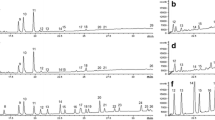Abstract
We compared a conventional method (Method I) for measuring plasma free fatty acid (FFA) concentrations with two more rapid procedures (Method II and Method III). Method I required total lipid extraction, separation of FFA by thin-layer chromatography, methylation, and gas-liquid chromatographic analysis of the fatty acid (FA) methyl esters. Method II was a colorimetric procedure. Method III relied upon diazomethane's presumed ability to selectively methylate FFA even in the presence of FA esters. The three methods were compared using plasma from fasted and from fed nude mice, tumor-bearing mice (MX-1 and ZR-75-1 human mammary carcinomas), and controls. Method II, was less reliable than Method I, but both gave similar mean values for plasma FFA levels in fasted mice. Both Methods I and II also showed similar lowering of plasma FFA levels after feeding previously fasted mice. Method III consistently gave values that were far greater than those obtained using Methods I and II. Moreover, highly significant differences between fasted and fed mice were obscured by direct methylation of plasma FFA with diazomethane (Method III). The excess FA methyl esters formed in Method III were derived from plasma phospholipids, but not from plasma triacylglycerols. After feeding fasted mice, plasma free palmitic acid and oleic acid levels fell (Method I); by contrast, the excess “FFA” formed by methylation of plasma phospholipid FA increased two-fold and fourteen-fold, respectively. Caution is therefore advised in the use of direct methylating agents when measuring total and individual plasma FFA levels.
Similar content being viewed by others
Abbreviations
- BHT:
-
3,5-di-t-butyl-4-hydroxytoluene
- DME:
-
Dulbecco modified Eagle's medium
- EDTA:
-
ethylenediaminetetraacetic acid
- FAME:
-
fatty acid methyl esters
- FFA:
-
free fatty acids
- FFAME:
-
free fatty acid methyl esters
- GLC:
-
gas-liquid chromatography
- PC:
-
phosphatidylcholine
- PE:
-
phosphatidylethanolamine
- PG:
-
phosphatidylglycerol
- PL:
-
phospholipids(s)
- PLFA:
-
phospholipid fatty acids
- PS:
-
phosphatidylserine
- TB:
-
tumor-bearing
- TG:
-
triacylglycerol
- TLC:
-
thin-layer chromatography
- TGFA:
-
triacylglycerol fatty acids
References
Hron, W.T., and Menahan, L.A. (1981)J. Lipid Res. 22, 377–381.
Baker, N., Gan-Elepano, M., Guthrie, B.A., and Mead, J.F. (1989)Lipids 24, 1028–1034.
Kannan, R., Gan-Elepano, M., and Baker, N. (1990)Cancer Res. 50, 2221–2227.
Pace-Asciak, C.R. (1989)J. Lipid Res. 30, 451–454.
Baker, N., Hill, V., and Ookhtens, M. (1978)Cancer Res. 38, 2372–2377.
Bligh, E.G., and Dyer, W.J. (1959)Can. J. Biochem. Physiol. 37, 911–917.
LePage, G., and Roy, C.C. (1988)J. Lipid Res. 29, 227–235.
LePage, G., and Roy, C.C. (1986)J. Lipid Res. 27, 114–120.
Author information
Authors and Affiliations
About this article
Cite this article
Lin, C., Blank, E.W., Ceriani, R.L. et al. Evidence of extensive phospholipid fatty acid methylation during the assumed selective methylation of plasma free fatty acids by diazomethane. Lipids 26, 548–552 (1991). https://doi.org/10.1007/BF02536602
Received:
Revised:
Accepted:
Issue Date:
DOI: https://doi.org/10.1007/BF02536602




